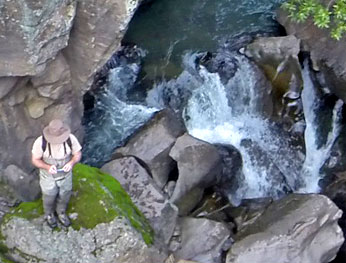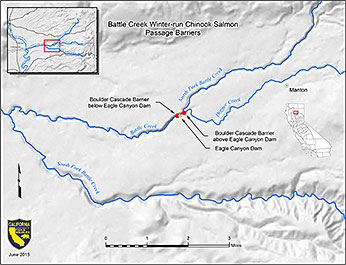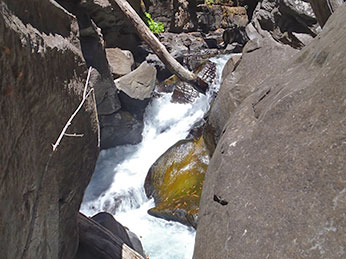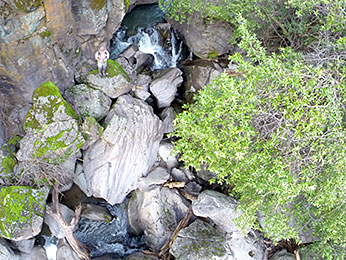(North Fork Battle Creek, Shasta & Tehama Counties)
Species Status
 Battle Creek Upper Barrier. Photo DKilliam.
Battle Creek Upper Barrier. Photo DKilliam.
 Battle Creek Barriers Map (click/tap to enlarge)
Battle Creek Barriers Map (click/tap to enlarge)
The Sacramento River winter-run Chinook salmon (Oncorhynchus tshawytscha) evolutionarily significant unit (ESU) has been federally listed as endangered since 1989. The species is also state listed as endangered under the California Endangered Species Act (CESA). The ESU is composed of only a single population, which spawn predominantly in a 5-mile stretch of the Sacramento River downstream of Shasta and Keswick dams. As it currently exists, this population of winter-run is considered to be perilously susceptible to the effects of multi-year droughts, which deplete the storage of cold water necessary for winter-run to successfully reproduce. In addition to winter-run, a restored Battle Creek is expected to support viable populations of spring-run Chinook salmon and steelhead; both of which currently persist with small populations in Battle Creek. Establishing viable populations for these three species in Battle Creek will directly satisfy part of the recovery criteria described in the National Marine Fisheries Service’s (NMFS) Final Recovery Plan for Central Valley Chinook Salmon and Steelhead.
Background/Location
Eagle Canyon is a steep, narrow gorge about 20 miles east of Cottonwood near the town of Manton in the North Fork of Battle Creek (see map). Battle Creek has historically been regarded as a uniquely important watershed because of the abundance and broad diversity of Chinook salmon and steelhead that used this stream. It is one of only a handful of Central Valley streams that historically supported steelhead and all four Chinook salmon runs, including winter-run, which need cold water throughout the summer for spawning and egg incubation (Lindley et al. 2004). The year-round influence of cold-water springs undoubtedly allowed for such diversity to develop.
Today, a winter-run population no longer occurs in Battle Creek. Hydroelectric facilities and operations and other human factors likely caused the extirpation of winter-run from the Battle Creek watershed in the early 1900s (Reynolds et al. 1993). Habitat loss and alteration resulting from this watershed development also led to declines in the abundance of wild spring-, fall-, and late fall-run Chinook salmon and steelhead.
The Battle Creek Hydroelectric Project, which is owned and operated by the Pacific Gas and Electric Company (PG&E), includes power diversion facilities on the North and South Forks of Battle Creek, including: Coleman Diversion Dam, Inskip Diversion Dam, South Diversion Dam, Wildcat Diversion Dam, Eagle Canyon Diversion Dam, and North Battle Creek Feeder Diversion Dam, and dams on Ripley Creek, Soap Creek, and Baldwin Creek.
The importance of restoring salmonid habitat in Battle Creek so that it can once again support viable populations of winter-, spring-, fall-, late fall-run Chinook salmon and steelhead has long been recognized. After many years of planning, there is currently a major restoration project being implemented on Battle Creek: The Battle Creek Salmon and Steelhead Restoration Project (Restoration Project). Under the Restoration Project, five of these dams will be removed (Wildcat Dam was removed in 2010), with the remaining three retrofitted with fish ladders and screens. Upon its completion, the Restoration Project will reestablish approximately 42 miles of prime salmon and steelhead habitat on Battle Creek.
Eagle Canyon Fish Barriers
Eagle Canyon is a narrow gorge that is over 200 feet deep with walls that are nearly vertical. The channel is a mixture of cascades and step-pools. Several large rocks in the channel are fish barriers that jeopardize the success of the Restoration Project. Two rock barriers are the focus of this project. One barrier (Figure 1.) is located approximately 600 feet downstream from the PG&E’s Eagle Canyon Diversion Dam, and second barrier (Figure 2.) is approximately 600 feet upstream of the dam near the confluence with Digger Creek.
 Figure 1. The downstream rock barrier site in Eagle Canyon on Battle Creek
Figure 1. The downstream rock barrier site in Eagle Canyon on Battle Creek
 Figure 2. The upstream rock barrier site in Eagle Canyon on Battle Creek.
Figure 2. The upstream rock barrier site in Eagle Canyon on Battle Creek.
The downstream barrier occurs within a debris field created by blasting associated with the construction of a tunnel and elevated flume. The upstream barrier is a 250-foot reach of rock-fall debris that has locally buried the channel with car-and bus-sized blocks of rock. Both sites occur in remote and very rugged locations that are not accessible by terrestrial vehicles. Developing fish passage through these barriers is critical for winter-run Chinook salmon success in Battle Creek.
Need for Program
The urgency of the ongoing Restoration Project is heightened by the facts that winter-run Chinook salmon are on the brink of extinction, California is currently experiencing a critical multi-year drought and current habitat is no longer suitable for the continued existence of the species. A restored Battle Creek presents a unique opportunity to establish a second population of winter-run in the only remaining suitable and volitionally accessible historic habitat in the Central Valley. The fact that the habitat is fed with cold water springs that provide a buffer against droughts makes restoring Battle Creek even more valuable. Successfully reintroducing and maintaining a viable population of winter-run into Battle Creek will be arguably the most significant step toward winter-run recovery that has been taken since the species was listed 25 years ago.
Future Efforts
At the conclusion of this fish passage design project, in early-2017, the Department will have design plans, specifications, and an engineer’s cost estimate to provide passage across these two barriers. Subsequently, the Department will seek funding to implement these plans, which will provide access to additional habitat.
Partners
The Battle Creek Salmon and Steelhead Restoration Project has been the result of a long planning process that culminated in a 1999 MOU between the: U.S. Bureau of Reclamation (BOR), U.S. Fish and Wildlife Service (USFWS), California Department of Fish and Wildlife (CDFW), and Pacific Gas and Electric Company (PG&E).
References
- Lindley, S. T., R. Schick, B. P. May, J. J. Anderson, S. Greene, C. Hanson, A. Low, D. McEwan, R. B. MacFarlane, C. Swanson, and J. G. Williams. 2004. Population structure of threatened and endangered Chinook salmon ESUs in California’s Central Valley Basin. U.S. Department of Commerce, NOAA Technical Memorandum NMFS-SWFSC-360
- Reynolds, F.L., Mills, T.J., Benthin, R., and Low, A. 1993. Restoring Central Valley Streams: A Plan for Action. California Department of Fish and Game, Inland Fisheries Division. Sacramento, California.